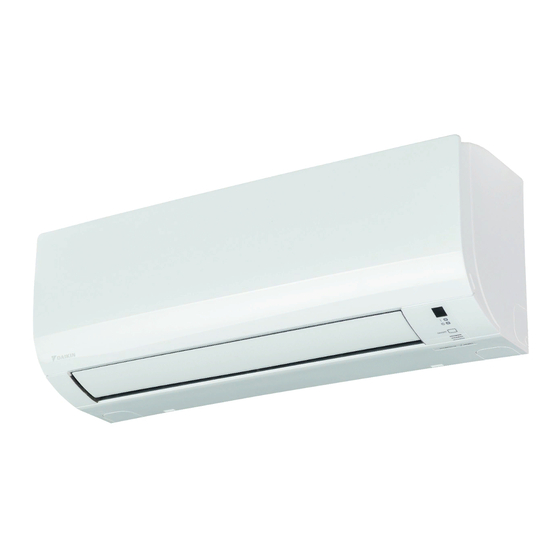
Table of Contents
Advertisement
Advertisement
Table of Contents

Summarization of Contents
Indoor Unit Components
Indoor Unit Overview
Details components of the indoor unit, including front panel, air inlet/outlet, louvers, flap, and sensors.
Outdoor Unit Components
Outdoor Unit Overview
Details components of the outdoor unit, including air inlet/outlet, sensors, and piping.
Remote Controller Components
Remote Controller Overview
Describes the functions and parts of the remote controller, including display and buttons.
Remote Controller Setup
Setting Remote Controller Batteries
Instructions for inserting batteries into the remote controller.
Remote Controller Operation Guide
Guidelines for using the remote controller and its communication range.
Mounting Remote Controller Holder
Steps for mounting the remote controller holder on a wall.
Remote Controller Notes
Important notes regarding battery usage, replacement, and remote controller handling.
Energy Saving and Operation Notes
Energy Saving Tips
Advice on how to use the air conditioner efficiently to save energy.
Operating Condition Notes
Important notes on power consumption and operating conditions.
AUTO DRY COOL HEAT FAN Operation Modes
Starting Operation
How to start the air conditioner by selecting an operation mode and pressing the ON/OFF button.
Stopping Operation
How to stop the air conditioner by pressing the ON/OFF button again.
Changing Temperature Setting
How to adjust the temperature setting for cooling, heating, or auto modes.
Operation Mode Details
Changing Airflow Rate
How to select the airflow rate for cooling, heating, or fan modes.
Notes on Operation Modes
Explanations for HEAT, COOL, DRY, AUTO, and FAN operations.
Adjusting Airflow Direction
Starting Auto Swing
How to activate the automatic swinging of the flap for upper and lower airflow direction.
Setting Flap Position
How to stop the flap at a desired position while in auto swing mode.
Airflow Direction Adjustments
Adjusting Vertical Louvers
Instructions on how to manually adjust the vertical louvers for airflow direction.
Airflow Direction Notes
Notes on airflow direction setting variations based on operation mode.
COMFORT AIRFLOW Operation
Starting COMFORT AIRFLOW
How to activate COMFORT AIRFLOW for a comfortable air distribution.
Cancelling COMFORT AIRFLOW
How to cancel the COMFORT AIRFLOW operation and return to memory position.
COMFORT AIRFLOW Notes
Notes on using COMFORT AIRFLOW with other operations.
POWERFUL Operation
Starting POWERFUL Operation
How to start POWERFUL operation for maximum cooling or heating effect.
Cancelling POWERFUL Operation
How to cancel the POWERFUL operation.
POWERFUL Operation Notes
Notes on functions not available and compatibility with other operations.
ECONO Operation
Starting ECONO Operation
How to start ECONO operation for efficient power consumption.
Cancelling ECONO Operation
How to cancel the ECONO operation.
ECONO Operation Notes
Notes on when ECONO operation can be set and its limitations.
OFF TIMER Operation
Using OFF TIMER
How to set the OFF TIMER for automatic shutdown at a desired time.
Cancelling OFF TIMER
How to cancel the set OFF TIMER.
Timer Operation Notes
Notes on timer memory and the NIGHT SET mode.
ON TIMER Operation
Using ON TIMER
How to set the ON TIMER for automatic startup at a desired time.
Cancelling ON TIMER
How to cancel the set ON TIMER.
Combining ON and OFF Timers
How to set both ON TIMER and OFF TIMER simultaneously.
Timer Reset Conditions
Conditions requiring the timer to be set again.
Care and Cleaning
Front Panel Cleaning
Instructions for cleaning the front panel of the indoor unit.
Air Filter Cleaning
Instructions for cleaning the air filters, including frequency.
Deodorizing Filter Care
Instructions for cleaning and replacing the titanium apatite deodorizing filter.
Cleaning Precautions
List of substances to avoid using for cleaning.
Maintenance and Refrigerant Information
Pre-Idle Period Preparation
Steps to prepare the unit for a long idle period.
Periodical Maintenance Recommendation
Recommendation for professional periodic maintenance of the air conditioner.
Refrigerant Information
Information about the refrigerant type and its global warming potential (GWP).
Troubleshooting Common Issues
Not Trouble Scenarios
Common situations that are not actual troubles and can be ignored.
Check Before Calling Service
Basic checks to perform before contacting a repair person.
Flap Swing Issues
Explanation for the flap not starting swing immediately.
HEAT Operation Interruption
Explanation for HEAT operation stopping suddenly due to defrosting.
Operation Start Delay
Explanation for delays in starting operation after power or mode changes.
Common Operating Sounds
Explanations for various sounds heard during operation or idle time.
Troubleshooting Operation Problems
Outdoor Unit Water or Steam
Explanations for water or steam emitted from the outdoor unit during different operations.
Sudden Operation Stops
Troubleshooting for sudden operation stops with flashing or on OPERATION lamps.
No Operation
Checks for the air conditioner not operating when the OPERATION lamp is off.
Hot Air Delay in HEAT
Explanation for hot air not flowing out immediately after starting HEAT operation.
Mist from Indoor Unit
Explanation for mist appearing from the indoor unit during COOL or defrost operations.
Troubleshooting Performance Issues
Poor Cooling or Heating Effect
Checks for poor performance, including filters, airflow, and settings.
Outdoor Fan Rotation Without Operation
Reasons for the outdoor fan rotating when the unit is not operating.
Remote Controller Malfunction
Troubleshooting steps for a non-functional remote controller.
Indoor Unit Odour
Explanation for odors emitted from the indoor unit and recommended actions.
Critical Troubleshooting and Disposal
Call Service Shop Immediately
Critical symptoms requiring immediate service and warnings about self-repair.
Power Failure and Lightning
How the unit behaves after a power failure and precautions during lightning.
Disposal Requirements
Information on proper disposal of the product and batteries according to regulations.
Fault Diagnosis
Error Code Display
How to access and interpret error codes displayed by the remote controller for fault diagnosis.
















Need help?
Do you have a question about the FTX35KMV1B and is the answer not in the manual?
Questions and answers